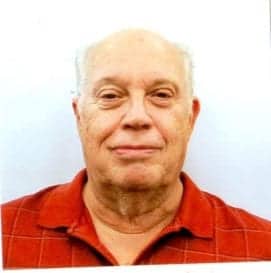This post provides details about what kind of weather to expect in London throughout the year.
We include average temperatures, average precipitation, and other important information to consider.
London is a great city to visit, no matter the time of year.
There’s plenty to do outside on gorgeous days, and inside on cold or wet days.
London tends to have fairly decent weather most months, although you’ll always want to have an umbrella on hand and at some times of the year warm clothing as well.
Below, you’ll find London’s average temperature by month, as well as the average number of days of rain and sun each month.
We also provide suggestions as to the attire you’ll want to pack by season for your visit.
SPRING WEATHER IN LONDON
The spring months are starting to warm up after the cold of winter, and at times days can be mild.
You’ll still have a cold morning or evening here or there, and you can expect rain.
SPRING AVERAGE TEMPS

Early In the Month
Daytime: 8-9 C (46-49F) | Overnight: 2-3 C (36-39 F)
Late in the Month
Daytime: 11-12 C (53-55F) | Overnight: 4-5 C (40-42 F)
Early In the Month
Daytime: 12 C (54 F) | Overnight: 4-5 C (40-42 F)
Late in the Month
Daytime: 15-16 C (49-51 F) | Overnight: 7-8 C (44-46 F)
Early In the Month
Daytime: 15-16 C (49-51 F) | Overnight: 7-8 C (44-46 F)
Late in the Month
Daytime: 18-19 C (64-66 F) | Overnight: 10-11 C (50-52 F)
SPRING AVERAGE RAIN AND SUN
Snow is rare during the spring months, although there is usually some precipitation and you can expect a good number of cloudy days.
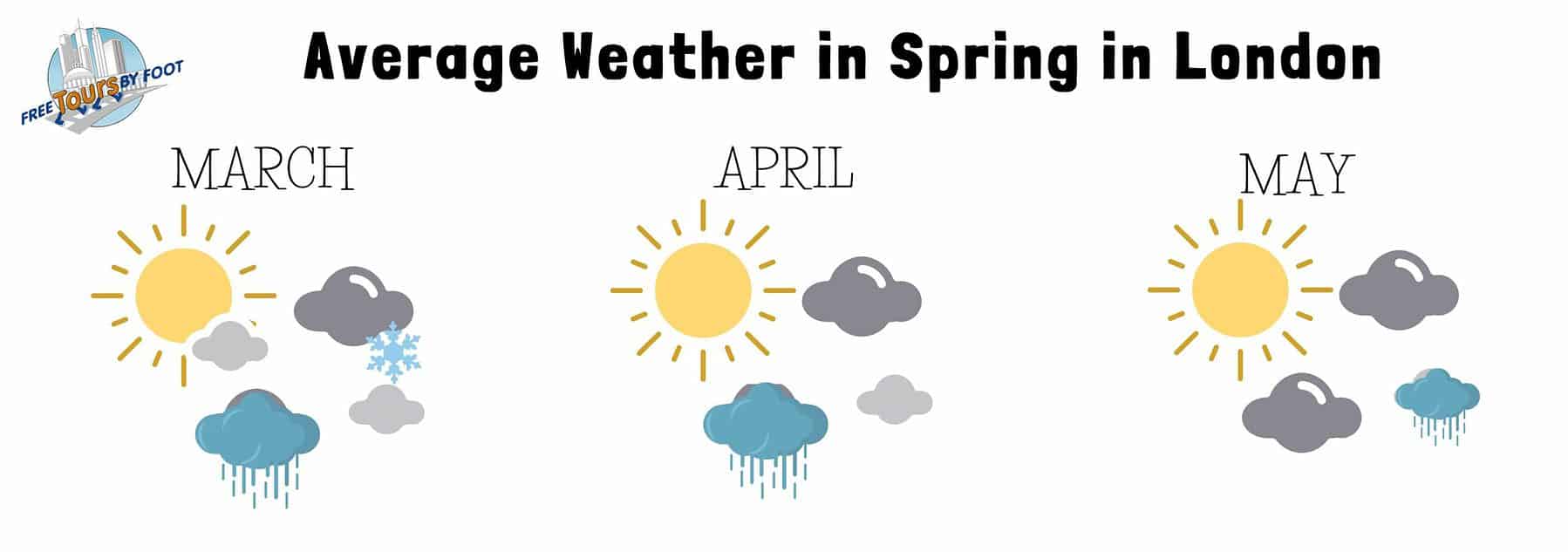
March
On average there will be around 17-18 mostly cloudy days.
Around 16 days will have precipitation, and 2 will likely have some snow.
April
About 13-14 days will have either sunny or at least partly sunny skies.
18-19 days will record some rainfall with one of these days reporting snow
May
About 14-15 days this month will have sunny or at least partly sunny skies.
About 15 days this month could see some rain.
However, only 6-8 days will be considered “rainy days” when at least 1 mm/0.04 inches of rain falls.
SPRING ATTIRE
In early spring you’ll want to dress in layers.
This will keep you warm over cold days, but items can be removed as days warm up.
In late spring a light to moderate weight jacket or coat will serve you well for those cold mornings or evenings.
And rain gear is a must throughout the spring. At the very least an umbrella will serve you well.
SUMMER WEATHER IN LONDON
The summer months move into comfortable temps.
You’ll still have a chilly morning or evening here or there, a bit of rain, and even a hot day or two.
However, for the most part, it’s a great time to be out and about in London.
SUMMER AVERAGE TEMPS
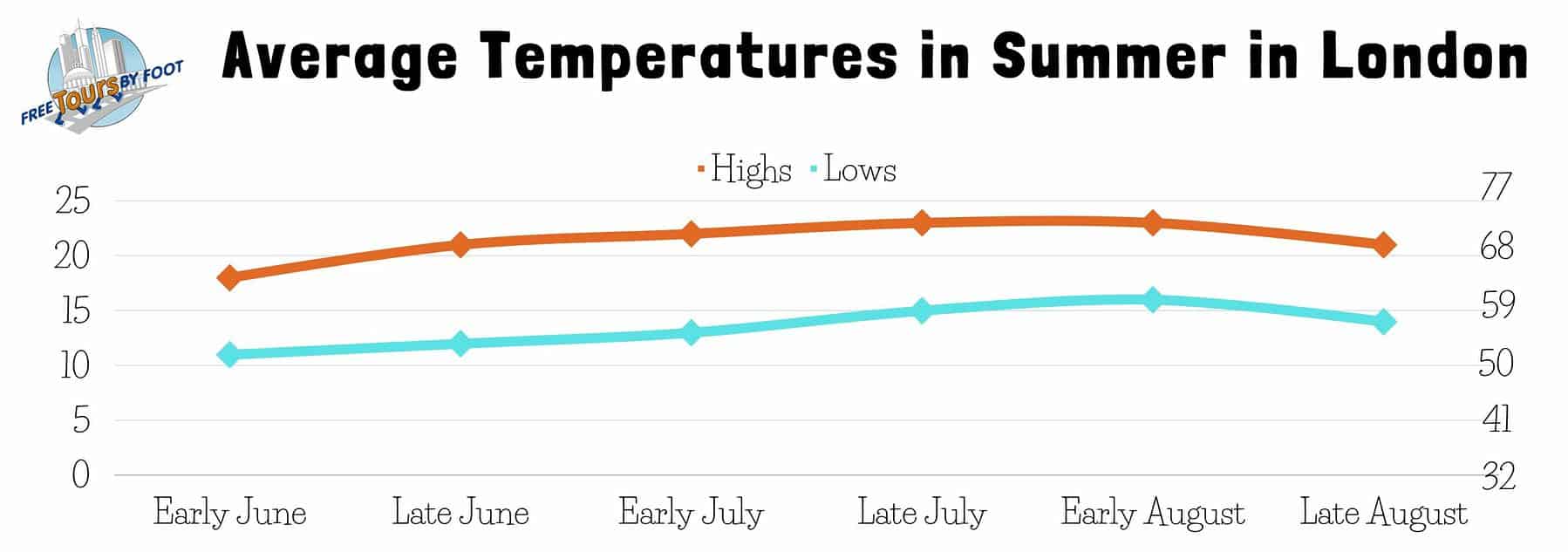
Early In the Month
Daytime: 18-19 C (64-66 F) | Overnight: 11-12 C (52-54 F)
Late in the Month
Daytime: 21-22 C (70-72 F) | Overnight: 13-14 C (55-57 F)
Early In the Month
Daytime: low-20s C (68-70 F) | Overnight: 10-12 C (50-54 F)
Late in the Month
Daytime: 22-23 C (72-74 F) | Overnight: 13-14 C (55-57 F)
Early In the Month
Daytime: low-20s C (low-70s F) | Overnight: 15-16 C (59-61 F)
Late in the Month
Daytime: 21 C (70 F) | Overnight: 13-14 C (55-57 F)
*note that there may be a couple of days in August that reach as high as 29 C (84 F).
SUMMER AVERAGE RAIN AND SUN

June
Cloudiness decreases during June with about 14-16 days having either sunny or at least partly sunny skies.
About 13 days this month will record some rainfall.
However, only about 7-8 days will record at least 1 mm (0.04 inches) or more rainfall.
July
Skies will be clear or at least partly sunny on 17-18 days this month.
About 14 days will have some rain.
However, only about 6 of these days will record 1mm (0.04 inches) or more.
August
There will be 17-18 days sunny or at least partly sunny skies in August, while only 7-8 days are likely to see rainfalls of 1mm (.04 inches) or more.
SUMMER ATTIRE
Summer tends to be comfortable in London.
Although the weather is increasingly warmer through these months, you will still need a mix of spring and summer clothes as the weather can be quite changeable.
A light jacket will be handy for those colder mornings or evenings.
As usual, it can’t hurt to have a small umbrella on hand for those days when the skies decide to open up.
AUTUMN WEATHER IN LONDON
Autumn is also a lovely time to visit London.
The weather is starting to cool down, there’s a good amount of drizzle, and daylight hours are decreasing, but it’s still comfortable outside.
AUTUMN AVERAGE TEMPS
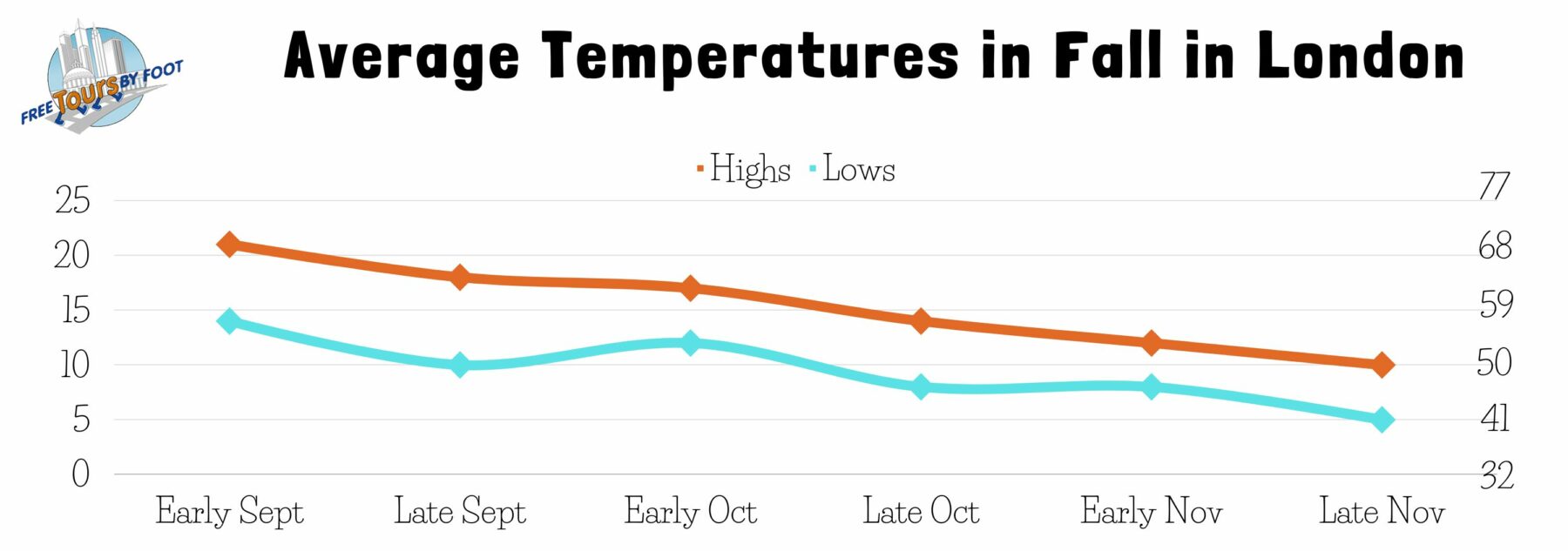
Early In the Month
Daytime: 21-22 C (70-72 F) | Overnight: 13-14 C (55-57 F)
Late in the Month
Daytime: 17-18 C (62-64 F) | *Overnight: 11-12 C (52-54 F)
*note that some mornings can dip as low as 8-9 C (46-48 F)
Early In the Month
Daytime: 17-18 C (62-64 F) | Overnight: 10 C (50 F)
Late in the Month
Daytime: 13-14 C (55-57 F) | Overnight: 7-8 C (44-46 F)
Early In the Month
Daytime: 13-14 C (55-57 F) | Overnight: 8-9 C (50 F)
Late in the Month
Daytime: 9-10 C (48-50 F) | *Overnight: 5-6 C (41-43 F)
*Note that some mornings late in the month may dip down as low as 1-2 C (34-36 F)
AUTUMN AVERAGE RAIN AND SUN
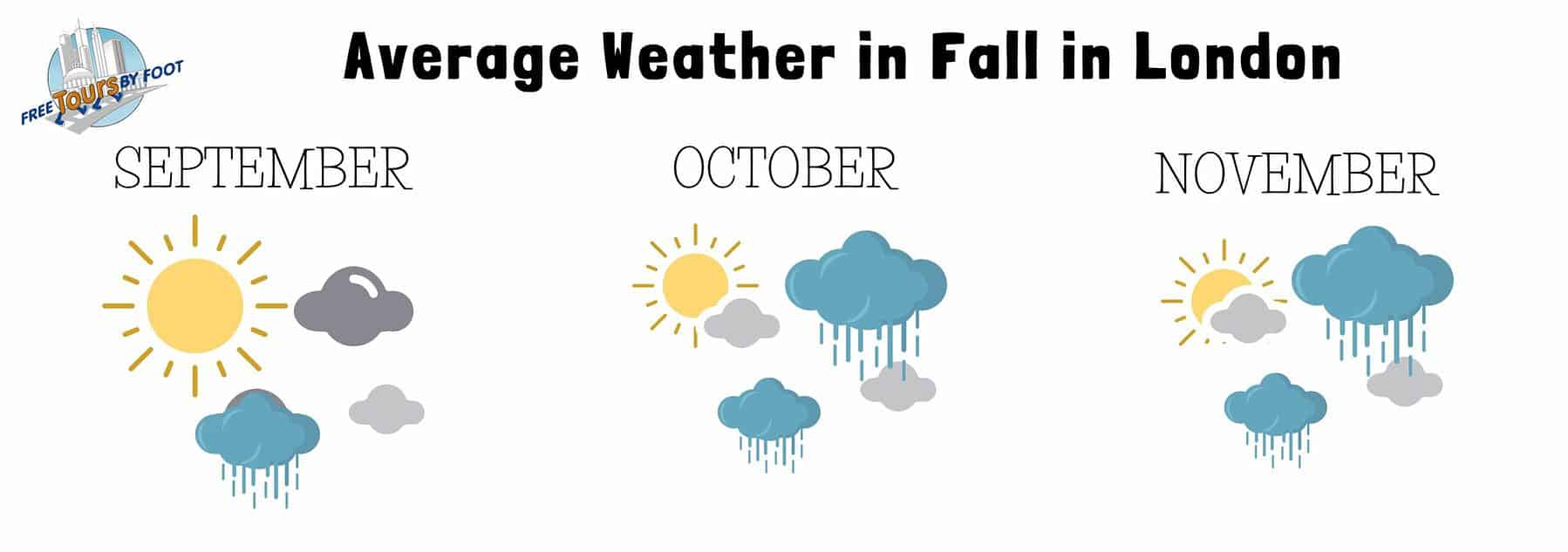
September
Skies will be clear or at least partly sunny on 14-16 days this month, offering ample time to explore London on foot.
About 15 days during September will record some rain; however, only 7-8 days will record at least 1 mm (0.04 inches) or more.
October
However, there are still about 13-15 days during this month that will see either sunny or partly sunny skies with the remainder of the month being mostly cloudy.
Some rain occurs on about 20 days this month with about 16 of these having moderate to sometimes heavy rains.
November
Skies will be cloudy or mostly cloudy on 21-22 days with some rainfall likely on about 17 days.
Snow is unlikely early in November; however, towards the end of November, the risk for some snow increases to about 5-10 %.
AUTUMN ATTIRE
As it is in late spring and summer, a light sweater or windbreaker may be all you need for the early morning and even afternoons late in the season.
You’ll definitely want to carry a waterproof jacket or umbrella because you can count on precipitation on many days.
As you get towards the end of November, you may want to consider having some winter attire on hand.
WINTER WEATHER IN LONDON
While it’s wet and cold in London during the winter months, it’s warmer than other surrounding areas because of the heat-island effect.
It’s also darker and windier than some other months, but it’s not likely there will be much snow.
WINTER AVERAGE TEMPS
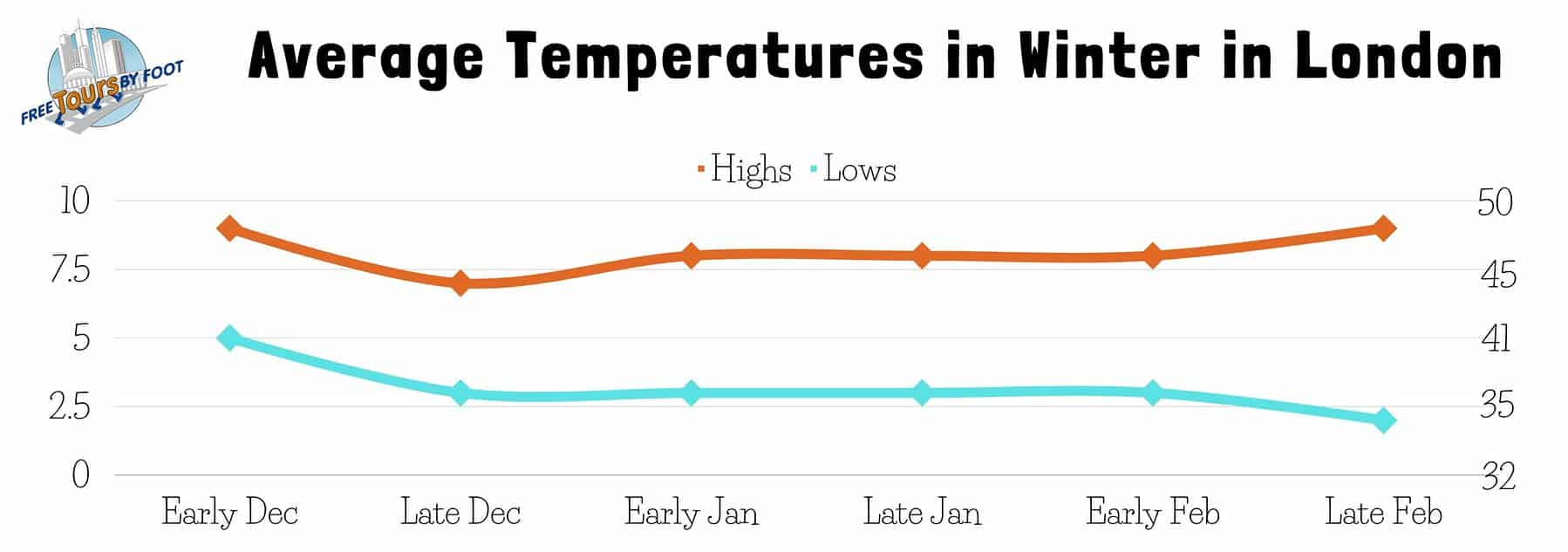
Early in the Month
Daytime: 9-10 C (48-50 F) | Overnight: 5-6 C (41-43 F)
Late in the Month
Daytime: 6-7 C (43-47 F) | Overnight: 3-4 C (37-39 F)
Early in the Month
Daytime: 8-9 C (46-48 F) | Overnight: 3-5 C (37-41 F)
Late in the Month
Daytime: 8-9 C (46-44 F) | Overnight: 3-5 C (37-41 F)
Early in the Month Late in the Month
Daytime: 7-8 C (44-46 F) | *Overnight: 3-5 C (37-41 F)
Late in the Month
Daytime: 9-10 C (48-50 F) | Overnight: 2-4 C (36-39 F)
*Note that some mornings can dip down to -1 to 0 C (30-32 F) or even lower.
WINTER AVERAGE RAIN AND SUN

December
Skies this month tend to be partly to mostly overcast with about 9-10 days seeing at least 1 mm (.04 inches) of precipitation, mostly falling in the form of light to moderate rain.
Some snow is reported here in December, but only over about 2-3 days.
January
About 9 days this month will be clear or at least partly sunny, while the remaining days tend to be cloudy or mostly cloudy.
You can expect at least a trace of precipitation this month on 18-19 days.
However, only about 9-10 days have precipitation amounts of at least 1mm (0.04 inches) or more, while snow falls on average on only about 2 days during January.
February
On average, about 10 days this month will see clear or at least partly sunny skies while about 18 days will be cloudy or mostly cloudy.
Rain or snow falls on about 15-16 days this month, however, only about 6-7 days record at least 1 mm (0.04 inches) of precipitation.
Snow is more likely early in the month than towards the end of the month, but only 3 days on average will see some snow.
It can also be a bit windy at times.
WINTER ATTIRE
You’ll want to be sure to pack warm clothes for a winter visit to London.
Think layers of clothes, a medium to thick weight coat, scarves, hats, gloves, and possible winter boots.
As with all other times of year, it’s best to carry an umbrella because there are sure to be many drizzly days.
What is the coldest month of the year in London?
Though the coldest time persists from December to January, the coldest month of the year in London is January.
The temperature in early January rises as high as 7-8 at day time and drops to as low as 3-5 C at night.
Later in the month, days become hotter and nights colder. In some cases, the temperature drops to 1 C.
Except for the initial 9 days, the weather remains cloudy, and you can expect precipitation for 18-19 days of this month.
The snowfall in January lasts for 2 on average. These 2 days are not necessarily consecutive.
What is the coldest month of the year in the UK?
January tends to be the coldest, although December and February are a close second.
What is the hottest month of the year in London?
The warmest month of the year in London is July.
The average temperature for this month is approximately 19 degrees Celsius (66 degrees Fahrenheit).
On certain days, the temperature may reach as high as 23 degrees Celsius (73 degrees Fahrenheit).
Nights of July are relatively less hot as compared to the daytime. Similarly, late July is relatively hotter than earlier in the month.
Overall you will see fluctuations in temperature throughout the summer season and even some days in July might force you to wear light leather jackets at night.
What is the hottest month of the year in the UK?
July and August tend to be the warmest
What is London’s annual rainfall?
23-24 inches
How many days of rain does London get annually?
Around 200 days
What is the wettest month in London?
The wettest months in London are usually October or November, sometimes even in December.
The overall monsoon season lasts from October to January, but most of the rain falls in October.
It's not just rain that makes this month the wettest.
A total of 20 days out of the month see some form of precipitation, with 16 of those seeing moderate to heavy downpours.
21 to 22 days will have cloudy or mostly cloudy skies, while about 17 days will see precipitation.
When does it snow in London?
London is not that famous for snow, but that doesn't mean that snow never falls in London.
If there’s going to be snow, you’ll usually find it in January or February.
Some amount of snow falls for about 12 days of winter.
The snowflakes don't stay over there longer and rightly melt away, making everything crystal clear.
The actual accumulation of snow, or what you call heavy snowfall in London, can be seen for about 2 days in January and 3-5 days overall in winter.
What are the busiest travel months in London?
The high season is usually July and August.







